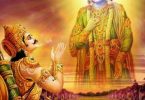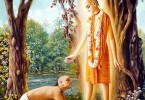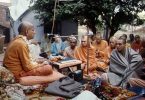Question: The Vedas state that eclipses are caused by the floating head of Rahu, but we have observed that eclipses are caused when the Moon orbits between the Earth and the Sun and casts a shadow. Since we are to take the Vedas as literal truth, how do you resolve this discrepancy?
Answer by Romapada Swami:
To secure a well-rounded and well-informed response to this common question, I both researched and consulted. Below summarizes my findings.
- Source: Antardwip Prabhu, TOVP Director
Before answering the question specifically, it will help to step back and consider the two different descriptions of the universe that are given in the Vedic Iiterature. Within the Puranas, we have the brahmanda presented as being half filled with water and in the other half fourteen planetary systems exist.
The planets such as sun and moon are described as being deities riding in chariots, and their orbits are vertically stacked one above the other within Svarga Loka. The earth is described as a massive plane stretching from one side of the universe to another.
In apparent contrast to this is the universe described in the Jyotir Veda, or Siddhantic literature. Therein, the earth is a small globe at the center of the universe, with various planets (also globes) circling in orbits around it, all basically moving within the same horizontal plane. Our experience of the universe as residents of Bharata Varsha is in line with this Siddhantic description.
Both of these Vedic presentations are factual and correct. We perceive only the second, whereas others can perceive the first, which is a higher manifestation of the universal reality.
In the Puranic cosmos, which describes the entire virat-rupa, the moon is situated in an orbit above that of the sun. As such, it is not possible for it to come between the earth and the sun. Thus, in that layout, there is another planetary body, which is called Rahu, and which is situated below the sun. When it comes between the earth and the sun, then we see a solar eclipse, and when it blocks the moon, then we experience a lunar eclipse.
In the Siddhantic cosmos, the planets are arranged at orbital distances from the earth according to the speed at which they make their revolution through the zodiac; faster planets are closer in and slower ones farther out. The moon is the fastest planet and therefore it is closer to the earth than all the other planets. Thus, in this layout it is possible for the moon to come between the earth and the sun and cause an eclipse.
However, this eclipse only occurs when the sun and moon are at, or near, the two points of intersection between their orbits. These points are known as Rahu. Thus, while the mechanistic explanation given in the Siddhantas seems to match the modern explanation, it still incorporates the idea of Rahu as being the cause of the eclipse.
Furthermore, within the Puranas it is described that when Rahu was killed by Mohin Murti, Brahma gave him the status of a planet (almost) and a body that was created from the shadow of the earth. As such, it is not actually the floating head, and he does not swallow the planet as some people claim. The Bhagavatam states that due to his lasting enmity towards the luminaries, he attacks, but is repelled by the Sudarshan Cakra; in fact, he never even touches the sun or moon.
So, there is no discrepancy between the idea of the orbits of planets with their casting of shadows and the attack by Rahu upon the sun or moon. The two are complimentary explanations of the same phenomena and are properly understood or experienced by persons who have the requisite karma to experience the universe in a certain way.
In conclusion, Rahu does cause eclipses, and at the same time, the cosmo-metrical arrangement described in the Jyotir Veda (and imitated by modern science) also describes what occurs mechanistically.
As a final note, while many speak of Ketu as also causing eclipses, it is not mentioned as such in the Surya Siddhanta. Additionally, within the Bhagavatam, Ketu, or the Ketus, are described as being comets, and they are the 100 brothers of Rahu. So there appears to be a mistaken idea that Ketu is also one of the causes of eclipses. For example, the authentic histories of Lord Caitanya’s appearance state that Rahu caused an eclipse at the time of His appearance. But if we cast an astrological chart according to modern Jyotish understandings, then it says that Ketu is eclipsing the moon. So there appears to be a significant amount of confusion that has crept in about Rahu; which is understandable considering it is his nature to cause such ignorance and obfuscation.
- Source: Vedic Cosmology and Astronomy by Richard Thompson (Sadaputa das)
If we go 80,000 miles above the region of the Siddhas, Cäraëas, and Vidyädharas, we come to the level of the planet called Rähu. Some 80,000 miles above Rähu we reach the level of the sun, which is said to lie between Bhürloka and Bhuvarloka in the middle of antarikña (SB 5.20.43, 5.24.1). We note that these measurements account for only part of the distance from Bhü-maëòala to the sun, since this is given as 100,000 yojanas (or 800,000 miles) in SB 5.23.9p.
In the Vedic literature it is often mentioned that Rähu causes solar and lunar eclipses by passing in front of the sun or moon. To many people, this seems to blatantly contradict the modern explanation of eclipses, which holds that a solar eclipse is caused by the passage of the moon in front of the sun and a lunar eclipse is caused by the moon’s passage through the earth’s shadow. However, the actual situation is somewhat more complicated than this simple analysis assumes.
The reason for this is that the Sürya-siddhänta presents an explanation of eclipses that agrees with the modern explanation but also brings Rähu into the picture. This work explicitly assumes that eclipses are caused by the passage of the moon in front of the sun or into the earth’s shadow. It describes calculations based on this model that make it possible to predict the occurrence of both lunar and solar eclipses and compute the degree to which the disc of the sun or moon will be obscured. At the same time, rules are also given for calculating the position of Rähu and another, similar planet named Ketu. It turns out that either Rähu or Ketu will always be lined up in the direction of any solar or lunar eclipse.
In Chapter 1 we have already described how the astronomical siddhäntas define the orbit of Rähu, and a similar definition is given for Ketu. The positions assigned to Rähu and Ketu correspond to the ascending and descending nodes of the moon – the points where the orbit of the moon (projected onto the celestial sphere) intersects the ecliptic, or the orbit of the sun. These nodal points rotate around the ecliptic from east to west, with a period of about 18.6 years. One of them must always point in the direction of an eclipse, since the moon can pass in front of the sun or into the earth’s shadow only if the sun, moon, and earth lie on a straight line. Thus, by placing Rähu and Ketu at the nodal points of the moon, the Sürya-siddhänta conforms both with the modern theory of eclipses and the Vedic explanation involving Rähu and Ketu.
One objection that may be raised to the explanation given in the Sürya-siddhänta is that it contradicts the Vedic statement that the moon is higher than the sun. However, we have seen that this statement refers to the height of the moon above the plane of Bhü-maëòala, and not the distance along the line of sight from the earth globe to the moon.
Another objection one might raise is that the explanation in the Sürya-siddhänta seems to be a cheap compromise between the Vedic account of eclipses (which many will regard as mythological) and the modern account (which many will regard as an import into India from the Greeks). It is true that Rähu and Ketu seem to play a rather superfluous role in the eclipse calculations given in the Sürya-siddhänta. However, there are reasons for supposing that these planets do not appear in these calculations as a mere decoration.
The principal reason for this is that the positions of Rähu and Ketu play an important role in astrology. This means that astrologers need some system of calculation that will tell them where Rähu and Ketu are at any given time. We have argued in Chapter 1 that astrology has traditionally played an important role in Vedic culture. From this it follows that some methods for calculating the positions of Rähu and Ketu have traditionally been required in Vedic society. Since we have no evidence that any other method of calculating these positions has ever been used, this can be taken as an indirect indication that the method used in the Sürya-siddhänta has co-existed with the Vedic çästras for a very long time.
Of course, by this argument we cannot conclude definitely that this particular method of calculation has always been used. But we can at least be sure that the Vedic society, with its emphasis on astrology and the astronomical timing of religious ceremonies, has always needed more than a mere qualitative story to account for eclipses and other astronomical phenomena.
In the West there is also a long tradition ascribing solar and lunar eclipses to the action of some celestial beings of a demonic nature. There these beings have also been associated with the nodes of the moon, and they are known as the head and tail of the dragon. The story of this eclipse-dragon may help give us some indication of how little we really know about history. Figure 16 is a medieval Islamic picture showing an angel severing the head of the eclipse-dragon. (This is reminiscent of the story of the decapitation of Rähu by Lord Viñëu.) Figure 17 [*Below] is a strikingly similar picture showing St. George, the patron saint of England, slaying a dragon. Unless this is a complete coincidence, it would seem that the story of the eclipse-dragon was somehow woven into the iconography of early Christianity without any indication of its significance being preserved. (St. George is said to have been born in Asia Minor in about A.D. 300, but there is apparently no information indicating how he came to be connected with a dragon. Unfortunately, our knowledge of the ancient history of this story is practically nonexistent.
- Source: Shyamasundara Prabhu (ASBSP), Astrologer
Some time ago, one sannyasi expressed to me that one may think that the sun is covered by clouds, snow or an eclipse, per SB 10.84.32-33. From this, it appeared to this sannyasi, that along with the description of Rahu swallowing the sun or moon, the Vedic understanding of eclipses is similar to that of modern science.
Actually modern science has the same view as Vedic if you understand the astronomy.
The Sun revolves around Earth, this describes a plane (surface), the Moon also revolves the Earth, this also describes a plane. The plane of the Moon’s orbit is at an angle of about 5° in relation to the plane of the Sun’s orbit which is the reference plane.
When two planes intersect, they describe a line.
When the Moon is below the Sun’s plane and then goes up and conjoins the Sun’s plane on its journey, that point is called the North Node of the Moon (because it going from South to North, from under to over) and then when the Moon in its journey again intersects the plane of the Sun going from north to south, that is called the South Node of the Moon (because the Moon is going from above the Sun’s plane to below it. In Vedic nomenclature the North Node = Rahu, and the South Node = Ketu.
The Moon intersects the 2 nodes once every month, and the Sun once a year.
So when the Sun is conjunct one of the nodes and the Moon does the same that is the only time an eclipse can take place. That is because now the Sun, Moon and Earth are all collinear — in a straight line in respect to each other.
So on a full moon day when this happens, the Earth is in the center and the Sun and Moon are each on or very close to a Node (how close determines the intensity of the eclipse) then we will see a Lunar eclipse.
And when the Sun and Moon conjoin on one of the nodes then there is a solar eclipse.
Thus Rahu-Ketu are very much part of eclipses.
The line of intersection of the two planes of the Sun and Moon is not stationary but gradually moves backward at a rate of about one revolution in 18 years.
The shadow of the Earth on the Moon is the Lunar eclipse and the Moon blotting out the Sun is the solar eclipse.
In a higher state of understanding even shadows have consciousness (perhaps this is the source of the idea that if a candala’s shadow falls on you it created impurity) so that is Rahu/Ketu have negative effects even though they appear to only be shadows.
- Source – Srilakshmi Oppecini’s (Sri Radha Govinda dasi’s) “The Wild Side. Inside.”
In the Vedic literature it is often mentioned that Rahu causes solar and lunar eclipses by passing in front of the sun or moon. It turns out that either Rahu or Ketu will always be lined up in the direction of any solar or lunar eclipse.
By digging into the world’s tradition, we find glimpses of Rahu and Ketu’s presence; in his book Vedic Cosmography and Astronomy, Dr. Richard Tompson, Ph.D. in Mathematics, writes:
In the West there is also a long tradition ascribing solar and lunar eclipses to the action of some celestial beings of a demonic nature. There these beings have also been associated with the nodes of the moon, and they are known as the head and tail of the dragon. The story of this eclipse-dragon may help give us some indication of how little we really know about history.
Dr. Tompson reports about a medieval Islamic picture showing an angel severing the head of the eclipse-dragon; he also describes how St. George, the patron saint of England, is customarily portrayed slaying a dragon. Dr. Tompson concludes:
Unless this is a complete coincidence, it would seem that the story of the eclipse-dragon was somehow woven into the iconography of early Christianity without any indication of its significance being preserved. St. George is said to have been born in Asia Minor in about A.D. 300, but there is apparently no information indicating how he came to be connected with a dragon . . .Unfortunately, our knowledge of the ancient history of this story is practically nonexistent.
Beyond the limited scope of modern awareness of history and of cosmic realities, the Vedic body of revelation routinely describes in great detail Rahu and Ketu’s nature and function. In that realm of infallible but esoteric knowledge it is reported that Rahu is the decapitated but deathless head of a devilish being. How did he get to this position? By deception, he had gained partial access to the nectar of immortality but was then punished by Mohini Murti, Visnu’s avatara. Rahu’s severed body remained as the separate identify of Ketu, a headless reptilian, an unusual but tremendously influential serpentine astral form.
5th Source: Ananda Caitanya das – Astrologer
According to the Brhat Parasara Hora Sastra, Rahu and Ketu are considered to be planets, despite the fact that they are shadow regions in space. They and other planets move counter-clockwise around the zodiac. For a solar eclipse to occur, a new moon event needs to take place close to Rahu, the North Node. In other words, a Solar Eclipse is a conjunction between Sun, Moon and Rahu.
Brhat Parasara Hora Sastra contains descriptions of all planets including Rahu and Ketu and they play an important role in astrology. The Puranas mention that Rahu/Ketu represent the head and tail of Svarbhanu*. Brhat Parasara Hora Sastra describes planets as being sources of incarnations of Vishnu; planets have certain characteristics, but they are just not personalities alone. Planets are “grahas“; they give the fruit of our karma in this earth. Especially Rahu/Ketu’s placement in our charts indicate the karmic axis which plays out in our present lives.
*A demon who disguised himself as a demigod and sat between the Sun god and Moon god when Mohini was distributing nectar to demigods. The Sun god revealed his true identity, which caused Mohini Murti to slash the head of Svarbhanu. At that moment, Svarbhanu split into Rahu and Ketu, making them exist eternally (since he tasted the amrta from Mohini) in a plane between the Sun and Moon. During an eclipse, it appears as if Rahu is swallowing the Sun as Rahu is an enemy of the Sun god.







